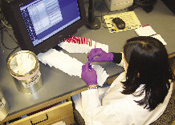FBI/DOJ Microscopic Hair Comparison Analysis Review
FBI/DOJ Microscopic Hair Comparison Analysis Review
FBI/DOJ Microscopic Hair Comparison Analysis Review
Updates:
- 6/10/16: Director Comey Letter to Additional Governors on State Reviews
- 2/26/16 Letter: Director Comey Letter to State Governors Requesting Additional Case Information from Prosecutors / Sample Letter to Prosecutors
- 4/20/15 Press Release: FBI Testimony on Microscopic Hair Analysis Contained Errors in at Least 90 Percent of Cases in Ongoing Review
- 4/19/15 Press Release: Department of Justice and FBI Joint Statement on Microscopic Hair Analysis
The FBI, in conjunction with the Department of Justice (DOJ), is engaged in a review of scientific testimony provided by FBI Laboratory examiners in cases involving microscopic hair comparisons.
The purpose of the review is to ensure that FBI Laboratory examiner testimony regarding microscopic hair comparison analysis met accepted scientific standards. In cases in which those standards were not met, remedial action may be taken if appropriate.
It’s important to note that microscopic hair comparison analysis is a valid scientific technique still conducted by the FBI Laboratory. The science of microscopic hair comparisons is not the subject of the review. In 1996, the FBI Laboratory developed and implemented mitochondrial DNA (mtDNA) analysis in conjunction with probative hair analysis because it is the most effective protocol for the forensic examination of hair, and it provides a more meaningful association than either technique used alone.
Cases with hair evidence recovered from a crime scene are examined both visually and through a microscope. If these hairs share similar characteristics with a known hair sample, a probative association may be established. A probative association can occur when there is a transfer of hair from a victim directly to a suspect or from a victim to the weapon used during the commission of a crime. Recovery of hair found inside a victim’s house that is microscopically similar to the victim’s hair is an example of a non-probative association because you would expect to find the victim’s hair in their home.
The FBI will review cases with a probative association if they meet the following criteria:
- The defendant was convicted;
- DNA analysis was not conducted on the evidentiary hair;
- The case was submitted to the FBI Laboratory and the analysis occurred prior to December 31, 1999; and
- The FBI provided the contributing law enforcement agency a Laboratory report regarding the results of the microscopic hair comparison.
The review is being conducted with the assistance of the Innocence Project (IP) and the National Association of Criminal Defense Lawyers (NACDL). Among other things, the IP and NACDL are providing an independent review of transcripts that meet the review criteria. This independent review is further described in: “The Hair Microscopy Review Project: An Historic Breakthrough For Law Enforcement and A Daunting Challenge For the Defense Bar,” originally published in the NACDL magazine, The Champion, July 2013.
As reviews are completed, DOJ provides the results of the FBI, IP, and NACDL reviews to prosecutors and defense counsel associated with the case.
While the FBI is working closely with the IP and the NACDL to identify relevant cases, the FBI welcomes the public’s assistance in identifying any cases that may be subject to this review—particularly those that occurred before 1982.
Further information can be obtained by contacting the FBI Hair Review Team at FBICaseReview@ic.fbi.gov.
08.16.10



